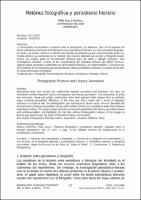Por favor, use este identificador para citar o enlazar este ítem:
https://repositorio.usj.es/handle/123456789/491
Registro completo de metadatos
| Campo DC | Valor | Lengua/Idioma |
|---|---|---|
| dc.contributor.author | Irala Hortal, Pilar | - |
| dc.date.accessioned | 2021-02-23T15:10:31Z | - |
| dc.date.available | 2021-02-23T15:10:31Z | - |
| dc.date.issued | 2011 | - |
| dc.identifier.citation | Irala Hortal, P. (1). Retórica fotográfica y periodismo literario. Estudios Sobre El Mensaje Periodístico, 17(1), 57-65. https://doi.org/10.5209/rev_ESMP.2011.v17.n1.3 | es_ES |
| dc.identifier.issn | 1134-1629 | es_ES |
| dc.identifier.uri | https://repositorio.usj.es/handle/123456789/491 | - |
| dc.description | Specialized texts have studied the relationship between journalism and literature, but have notconsidered another important fusion: photography and literary journalism. The conjunction of thesetwo text types, visual and written, particularly when both approach their subject from an aestheticangle, increases journalistic efficiency. In the same way that a writer uses a series of linguisticresources to construct text, the photographer uses techniques to do the same. KRAMERdescribes thecharacteristics of literary journalism and we will consider whether it is possible to adapt these featuresto photojournalism. The present paper describes some prime guidelines that literary journalism shareswith photojournalism, and highlights the fact that without photographic analysis of the images inliterary journalistic texts, the study of this kind of story is incomplete. | es_ES |
| dc.description.abstract | La Periodística ha estudiado la relación entre el periodismo y la literatura, pero no ha reparado de forma suficiente en la fusión de la fotografía con el periodismo literario. La unión de ambos lenguajes, el visual y el escrito, refuerza la eficacia del mensaje periodístico ya que narra el mundo desde una mirada estética que profundiza en la realidad. Este estudio defiende que escritor y fotógrafo poseen ambos una amplia gama de herramientas retóricas para dar datos y dibujar contextos. Esta investigación describe, a través de las características del periodista literario que define KRAMER, algunas pautas esenciales compartidas por el Periodismo literario y el Fotoperiodismo, y concluye que sin el análisis de las fotografías que acompañan los relatos periodístico-literarios, el estudio de ese tipo de textos permanece incompleto. | es_ES |
| dc.format.extent | 9 p. | es_ES |
| dc.format.mimetype | application/pdf | es_ES |
| dc.language.iso | spa | es_ES |
| dc.publisher | Ediciones complutense | es_ES |
| dc.relation.requires | Adobe PDF | es_ES |
| dc.rights | Atribución 4.0 Internacional | * |
| dc.rights.uri | http://creativecommons.org/licenses/by/4.0/ | * |
| dc.subject | Fotografía | es_ES |
| dc.subject | Fotoperiodismo | es_ES |
| dc.subject | Literatura | es_ES |
| dc.subject | Periodismo | es_ES |
| dc.subject | Reportaje | es_ES |
| dc.subject | Retórica | es_ES |
| dc.title | Retórica fotográfica y periodismo literario | es_ES |
| dc.title.alternative | Photographic Rhetoric and Literary Journalism | es_ES |
| dc.type | journal article | es_ES |
| dc.subject.unesco | Fotografía | es_ES |
| dc.subject.unesco | Periodismo | es_ES |
| dc.subject.unesco | Literatura | es_ES |
| dc.relation.publisherversion | https://revistas.ucm.es/index.php/ESMP/article/view/36945 | es_ES |
| dc.identifier.publicationfirstpage | 57 | es_ES |
| dc.identifier.publicationlastpage | 65 | es_ES |
| dc.identifier.doi | 10.5209/rev_ESMP.2011.v17.n1.3 | es_ES |
| dc.rights.accessRights | open access | es_ES |
| Aparece en las colecciones: | Artículos de revistas | |
Ficheros en este ítem:
| Fichero | Descripción | Tamaño | Formato | |
|---|---|---|---|---|
| Retórica fotográfica y periodismo literario.pdf | 73,61 kB | Adobe PDF |  Visualizar/Abrir |
Este ítem está sujeto a una licencia Creative Commons Licencia Creative Commons

